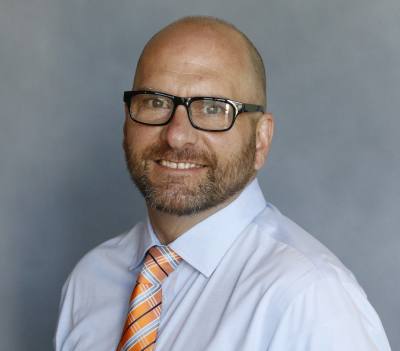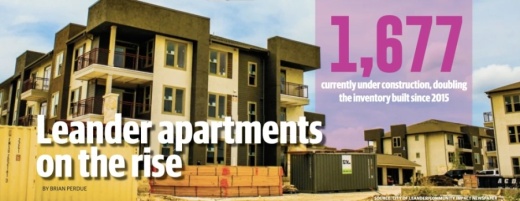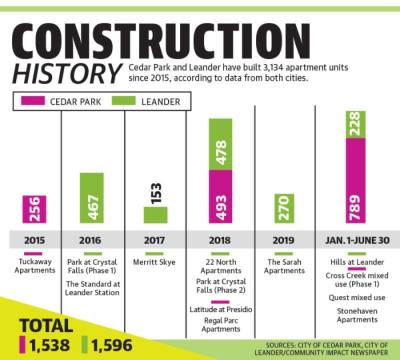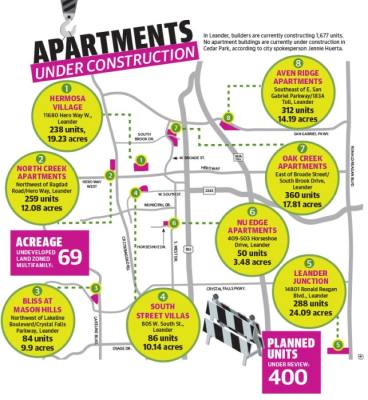As of June 30, developers have built 1,596 apartment units in Leander since 2015, which is comparable to Cedar Park’s 1,538 total during that same time. However, Leander’s apartment development is increasing quickly and will continue to do so, according to city data.
Leander has 1,677 apartment units in eight complexes currently being built—surpassing the total number of apartments built in the city built between 2015 and June 30, according to city documents. Cedar Park currently has no apartments under construction, according to city spokesperson Jennie Huerta.
Leander Mayor Troy Hill said the city is working to make future apartments more attractive and stand the test of time.
“Apartments typically don’t age well,” he said. “They do well initially because they’re the new thing, but after a few years something else is built, and they lose that attraction of being new.”
According to city spokesperson Mike Neu, properties currently zoned multifamily must now include garages for at least 75% of the units. All future multifamily developments must include a mixed-use component.
While State House Bill 2439 in 2019 removed the ability for cities to regulate building materials, Leander promotes masonry facades and other higher quality materials through developer agreements, Neu said.
When Planned Unit Developments, or PUDs, are proposed, the city requires the use of masonry in developer agreements, according to Neu.
“What I tell apartment developers now is, ‘you have to knock it out of the park,’” Hill said. “They need to be mixed-use; they have to be built well.”Hill said previous councils approved the apartment projects that residents are seeing now. He was elected in 2018.
Leander is currently crafting its 2020 comprehensive plan. Scheduled to be completed by December, Hill said the plan will include stricter standards for all multifamily construction compared to the last plan in 2015.
A need for housing
From 2018-19, Leander was the fastest-growing large city percentage-wise in the U.S., according to the U.S. Census Bureau. From July 1, 2018, to July 1, 2019, Leander’s population grew by 12% to 62,208 residents, according to census data.
Apartments can serve those who are not ready for or cannot afford a home or simply want to downsize, city and county sources said. Mixed-use apartment areas offer a more urban, walkable environment compared to suburban homes.
“Apartments often provide more flexible housing options for people who are not ready to own a home or who have transitioned to a new location,” Leander Planning Director Robin Griffin said. “Service industry employees who see home ownership as cost-prohibitive are more likely to live in an apartment.”
Griffin said apartments can serve as a draw for service industry business development.
“If more apartment options are available, it could encourage more service industry development,” she said.Larry Gaddes, the Williamson County tax assessor-appraiser, said the effect of apartment construction on infrastructure and home value can vary. He said when a three-story apartment complex was built off SH 130 in Hutto, the Hutto Fire Department needed to buy a ladder truck because the city previously did not have to protect buildings that tall.
Conversely, the density of apartments, compared to single-family home subdivisions, can sometimes be more manageable from a public safety standpoint.
“How many police does it take to patrol 15 complexes versus 1,500 homes?” Gaddes said.
Balanced development
Apartments—especially complexes without mixed-use components—can put a strain on infrastructure, such as schools and roads, if not planned properly, according to Griffin.
“Higher-density residential developments, such as stand-alone apartment complexes, tend to generate greater impacts on shared infrastructure,” Griffin said.
Leander ISD has recently been building a new school annually to meet enrollment demand, caused mostly from new single-family home developments in Leander, according to LISD documents.
Development in Leander accounts for 60% of all new housing in the nearly 200-square-mile district, said Jimmy Disler, LISD chief facilities and operations officer, during a February joint meeting with LISD and Leander city officials.
Large, planned communities such as Northline, which has been approved to build 2,403 units, and the recently proposed District 2243, which is requesting 2,050 multifamily units but has yet to be approved, will be mixed-use, according to city documents. An undetermined number will be condos or townhomes. Cedar Park also has large mixed-use communities planned in Indigo Ridge (4,500 units) and the Bell District (1,300 units).
“In a true mixed-use environment, where employers and commerce complement residential development, higher densities can also help grow and diversify a city’s economy,” Griffin said.
Compared to Austin, Leander and other Austin-area cities have the luxury of being able to plan on a large scale, according to Susan Horton, the 2020 president-elect for the Austin Board of Realtors.
She said a mix of housing is essential.
“A balance of single-family and multifamily properties, including townhomes and condominiums, is needed in a healthy housing market,” Horton said.







